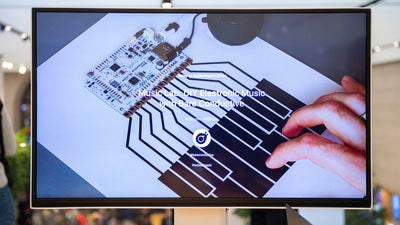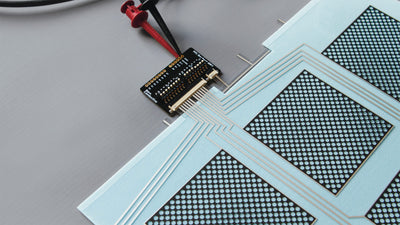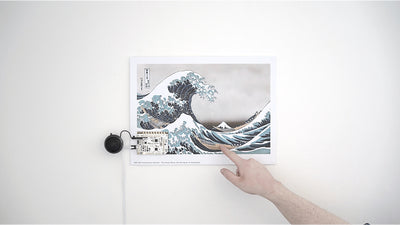Touch Board Clones: The Hardware isn’t the Hard Part

When our Touch Board was cloned we realized that the board was less significant than the ecosystem around it
Update! Check out our clone spotting guide
You may have heard that our Touch Board has been cloned. If you haven’t, you can read the whole story below. Make sure to checkout our guide below to find out what separates a real Touch Board from a counterfeit device. Download the PDF (381 kB)
Thanks Grumpy Mike
Earlier this year we saw a question pop up on the Arduino Forum. Someone was having trouble with their Touch Board. By the time we had signed in a few other users had figured out that something was amiss. The ‘Touch Board’ wasn’t behaving as expected and it didn’t seem to respond to the basic tests we suggest in our FAQs, nor was it accepting any new code from the Arduino IDE. A super-user friend of ours (“Grumpy Mike”) had the instinct to ask for a photo of the board to confirm its physical condition and whether or not it was genuine. Mike was right on. When the photo came back, everyone at Bare Conductive was shocked. It was a clone! It looked like a Touch Board and used our trademarked name, but clearly had not been manufactured by us. We had mixed emotions. We were upset because someone was having a bad experience with a product that they thought was ours, but we also felt flattered to have been copied.
We had expected for a while that clones would surface and now they had. The user on the Arduino forum was generous enough to perform some more tests on the board (we offered them a genuine Touch Board as compensation for their help) and with the user’s problems sorted; we had to figure out what to do next. When someone creates a board that is visually similar to ours, but of terrible quality, they tarnish our reputation. We had to take action, but what tools did we have to work with and what could we do?
Defending open hardware
The Touch Board is an Open Hardware project, and in with respect to that our design files are available for download and we would encourage people to make their own and change the design to suit their specific needs. What we don’t allow (like many Open Hardware companies) is the use of our trademarks. We think its awesome if someone makes their own board based on our designs, we don’t think its awesome when someone makes a board intended to fool consumers into thinking its one of ours by bastardising our logo and visual language. It is unethical and illegal.
Our first step was to buy a cloned board. Second, while waiting for our ‘Touch Board’ to arrive, we called our attorneys. We have comprehensive trademark protection for our products in multiple territories. We sent a letter to the manufacturer in China, referencing our IP and letting them know that we were aware of their actions and that they were violating Chinese law. Did we expect that this would stop them from producing more boards? No, not really, but letters from a lawyer are essential for establishing a precedent. We knew that the only levers available to us were our brand and our community.
Hardware isn’t the hard part
Designing the Touch Board wasn’t easy. There are a ton of features on a board not much bigger than an Arduino including capacitive touch, an MP3 player, a MIDI synthesiser, a LiPo charger and a Micro SD cardholder. There is a lot of work in this device. The fundamental design of the board was challenging. Creating a reliable capacitive touch and proximity platform was challenging. Designing the board to pass EU and US EMC compliance (CE and FCC) was challenging.
But none of this was as challenging as convincing someone that they should choose to use a Touch Board over all of the other Arduino-compatible devices. That’s not an engineering challenge that is a business challenge. This is a challenge that we must approach with our philosophy of making our hardware easy to use and available to every type and level of expertise.
Is it important that the Touch Board passes all US and EU rules for electromagnetic interference? Of course. Is it important for the person who just wants to make an open MIDI controller? Probably not. What is important to them is that we have a product that is easy to use, has tons of support and is reliable. We don’t believe the hardware has anything to do with those three requirements.
When we got the clone into our hands we found that it hadn’t been programmed. At all. Not even a boot loader. It’s similar to buying a new car to find that not only does it not have fuel, it doesn’t even have a fuel tank. The genuine Touch Board on the other hand comes pre-programmed with an audio guide giving you a tour of the features. That is like buying a car with a full tank and your favourite destinations already programmed into the satnav.
Was the audio guide a hardware innovation? Nope. The audio guide was a result of us trying to understand how people would react to and use the board straight out of the box. We’ve found that this simple feature is as popular with first time users as it is with Arduino pros. The first time user is able to swap the MP3s on the Micro SD card and instantly create something great, while the expert can listen to the features of our amazing libraries, sparking ideas for what they can do with our super robust capacitive touch and distance sensing. Could the clone have this functionality? Yes, in theory, but probably not in reality. We’ve found that due to what seems to be manufacturing errors and poor component selection, the clone that we have won’t ever work. But even if the clone were to be fully functional, it wouldn’t be enough. The cloned Touch Board only copies the smallest piece of a design process that builds user experience and meaning on top of hardware innovation.
Value is built on top of hardware
Focusing on the user experience doesn’t make the clone go away, so we’ll keep sending letters and keep reminding our community what our real logo looks like and where our legitimate distributors are. More importantly we’ll continue focusing on more than just the hardware. Just in the last month we’ve had two major releases that create even more value on top of the Touch Board.
The Touch Board Workshop Manual is an amazing document detailing all the things we’ve learned about Electric Paint and the Touch Board in the last three years. We’ve also recently released the Touch Board Arduino Plugin Installer, a multi platform (Mac, Windows and Linux) installer that puts all of our libraries and examples in the right place. We think the installer (like the audio guide) is just as useful for first time users as it is for experts. No one likes copy and pasting folders and following file path instructions.
We’re a small company with big ideas, but our power lies in the engagement of the thousands of community members that make our products their own and tell us what they think our next step should be. This is the most exciting part of what we do. Do we need high quality hardware to do this? Of course, but that alone is not enough. We also need everything that goes alongside it and that is much harder to copy. In short it’s taken me over 1000 words to say something that a well-loved English poet said in 25, so I’ll leave it to him to wrap it up:
They copied all they could follow
but they couldn’t copy my mind
so I left them sweating and stealing
a year and a half behind.
Rudyard Kipling
Stay connected with Bare Conductive. Follow, like and comment on Facebook, Twitter & Instagram.





